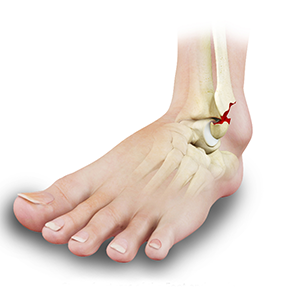Stress Fractures of Foot and Ankle

What is a Stress Fracture?
A stress fracture is described as a small crack in the bone which occurs from an overuse injury of a bone. It commonly develops in the weight-bearing bones of the lower leg and foot. When the muscles of the foot are overworked or stressed, they are unable to absorb the stress and when this happens the muscles transfer the stress to the bone which results in stress fracture.
Causes of Stress Fractures
Stress fractures are caused by a rapid increase in the intensity of exercise. They can also be caused by impact on a hard surface, improper footwear, and increased physical activity.
Athletes participating in certain sports such as basketball, tennis or gymnastics are at a greater risk of developing stress fractures. During these sports the repetitive stress of the foot strike on a hard surface causing trauma and muscle fatigue. An athlete with inadequate rest between workouts can also develop stress fracture.
Females are at a greater risk of developing stress fracture than males, and may be related to a condition referred to as “female athlete triad”. It is a combination of eating disorders, amenorrhea (irregular menstrual cycle), and osteoporosis (thinning of the bones). The risk of developing stress fracture increases in females if the bone weight decreases.
Symptoms of Stress Fractures
The most common symptom is a pain in the foot which usually gets worse during exercises and decreases upon resting. Swelling, bruising, and tenderness may also occur at a specific point.
Diagnosis of Stress Fractures
Your doctor will diagnosis the condition after discussing symptoms and risk factors and examines the foot and ankle. Some of the diagnostic tests such as X-ray, MRI scan or bone scan may be required to confirm the fracture.
Treatment of Stress Fractures
Conservative Method:
Stress fractures can be treated by non-surgical approach which includes rest and limiting the physical activities that involve foot and ankle. If children return too quickly to the activity that has caused a stress fracture, it may lead to chronic problems such as harder-to-heal stress fractures. Re-injury can also occur without allowing the stress fracture to completely heal.
- Protective footwear may be recommended which helps to reduce stress on the foot. Your doctor may apply a cast to the foot to immobilize the leg which also helps to remove the stress.
- Crutches may be used to prevent the weight on the foot until the stress fracture is healed completely.
- Metabolic Balance: with Vitamin D & Calcium
- Bone Stimulator: at home regiment
- Shockwave Therapy Treatment: 1x/week for 3 weeks in office
Surgical Method
In the case that surgery is required treatment is usually open reduction internal fixation (ORIF) using screws and plates. While critical anatomical alignment of the join tis essential, so too is evaluation of the articulating surface and cartilage. Dr. Kennedy and his team use intra-operative arthroscopy to ensure the joint is congruently reduced. This also facilitates delivery of biologic augments to try and heal any cartilage injury as cartilage has little to no capacity to heal on its own. Addressing the intra articular pathology as well as the bony fixation reduces the likelihood of post traumatic osteoarthritis (PTOA) which is a common sequalae to ankle fractures.
Prevention of Stress Fractures
Some of the following measures may help to prevent stress fractures:
- Ensure to start any new sport activity slowly and progress gradually
- Cross-training: You may use more than one exercise with the same intention to prevent injury. For example, you may run on even days and ride a bike on odd days, instead of running every day to reduce the risk of injury from overuse. This limits the stress occurring on specific muscles as different activities use muscles in different ways.
- Ensure to maintain a healthy diet and include calcium and vitamin D-rich foods in your diet.
- Ensure that your child uses proper footwear or shoes for any sports activity and avoids using old or worn out shoes.
- If your child complains of pain and swelling, then immediately stop the activities and make sure that your child rests for a few days
















